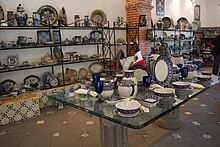Uriarte Talavera
This is a kind of majolica, named after the city of Talavera de la Reina which had developed in Spain from Arab and Chinese origins and brought to Mexico after the Spanish conquest of the Aztec Empire.
While majolica was made in a number of places in Mexico, it became highly refined in the Puebla city area, especially from 1650 to 1750.
Talavera work is distinguished by the fine clays found in this area, fired with a tin and lead glaze at high temperatures.
[4][5] In 1897, Catalan artist Enrique Luis Ventosa arrived to Puebla at a time when craft was in danger of disappearing.
[3] Starting in 1922, Ventosa began to work with Ysauro Uriarte Martinez, who had just inherited Dimas's workshop.
The two also experimented with some other designs such as a revival of Hispano-Muslim lusterware and firing oxides at different temperatures to change the appearance of the glazes.
[4] Uriarte makes about 20,000 pieces a month on average, with about half of the production exported to the United States, France, Italy, Egypt, Australia, Chile and other countries.
[4] The workshop has worked with artists such as José Luis Cuevas, Jan Hendrix, Ricardo Regazzoni, Manuel Felguérez and Georgina Farias to create new designs.
[7] Pieces from the workshop can be seen in the permanent collections of the Museo José Bello y Gonzalez in Puebla and the Franz Mayer Museum in Mexico City .





